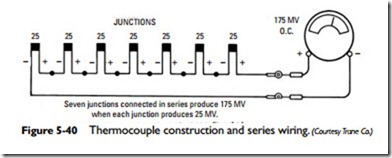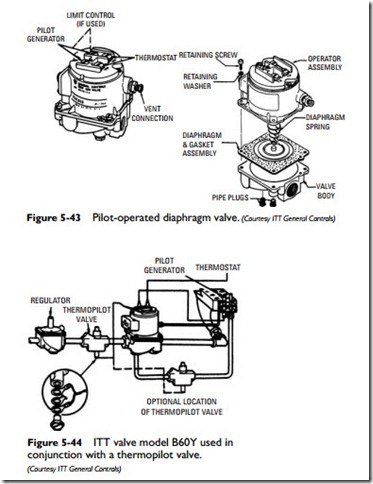Thermopiles (Pilot Generators)
The amount of electrical energy generated by a thermocouple that has a single hot junction and a single cold junction (i.e., approximately 25 millivolts) is considered adequate for most residential heating equipment. However, a few residential furnaces and boil- ers and most commercial types require a higher voltage. An increase in voltage can be obtained by using a number of thermo- couples wired in series (see Figure 5-40). A series of thermocouples in one unit is called a thermopile, pilot generator, or thermopile generator. A thermopile forms a part of a millivolt or self-energizing control circuit.
An example of a thermopile used in gas-fired heating equipment and appliances is shown in Figure 5-41. This particular unit produces
A millivoltmeter must be used to test a thermopile. The meter leads are attached to the valve or relay terminals to which the wires of the pilot generator are also attached.
The thermostat must be calling for heat and the pilot burning during a millivoltmeter test.
Pilot-Operated Diaphragm Valves
A pilot-operated diaphragm valve is used to provide automatic shut- off of main line gas when there is an unstable pilot flame or no flame at all. These valves are operated by electrical energy (millivoltage) produced by the pilot generator. Their operation is controlled by the room thermostat, limit devices, and other operating controls.
The ITT General Controls B60 gas valve (see Figure 5-43) is an example of a pilot-operated diaphragm valve commonly used with gas-fired heating equipment. Where 100 percent shutoff is required, it should be used in conjunction with a thermopilot valve (see Figure 5-44).
Combination Gas Valves
A combination gas valve (or combination gas control) combines in a single unit all manual and automatic control functions required for the operation of gas-fired heating equipment. In other words, a single valve replaces the various individual pilot line and main line gas controls. A gas-pressure regulator is usually optional.
Many manufacturers of gas controls offer a complete line of combination gas valves; each valve is designed for a different kind of installation or application. Usually these valves will differ on the basis of the controller voltage or voltage source, valve application or function, required Btu capacity for the installation, and type of gas used.
Honeywell manufactures a line of standardized and inter- changeable gas control components. A complete preassembled combination gas control can be ordered from the factory or one can be assembled in the field from a variety of different standardized components in order to meet the needs of a particular installation. This add-on feature also allows field replacement of a defective component without removing the complete valve from the installation. A number of possible combinations are illustrated in Figures 5-45 and 5-46.


